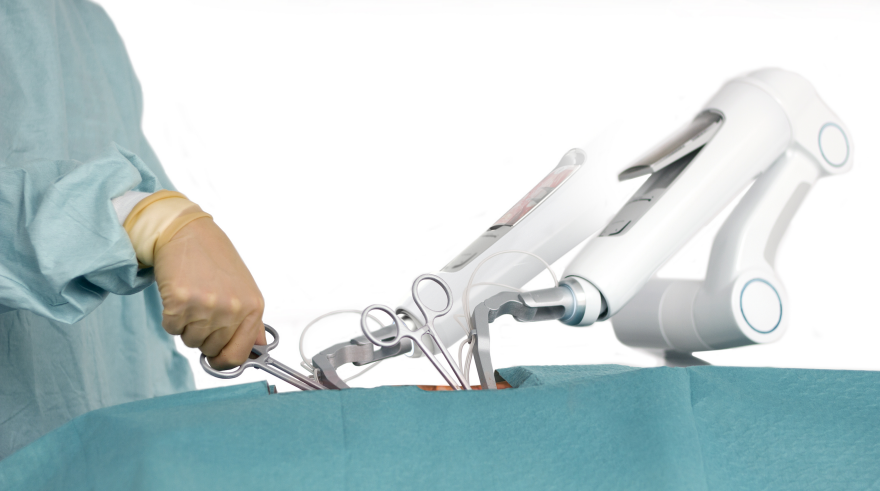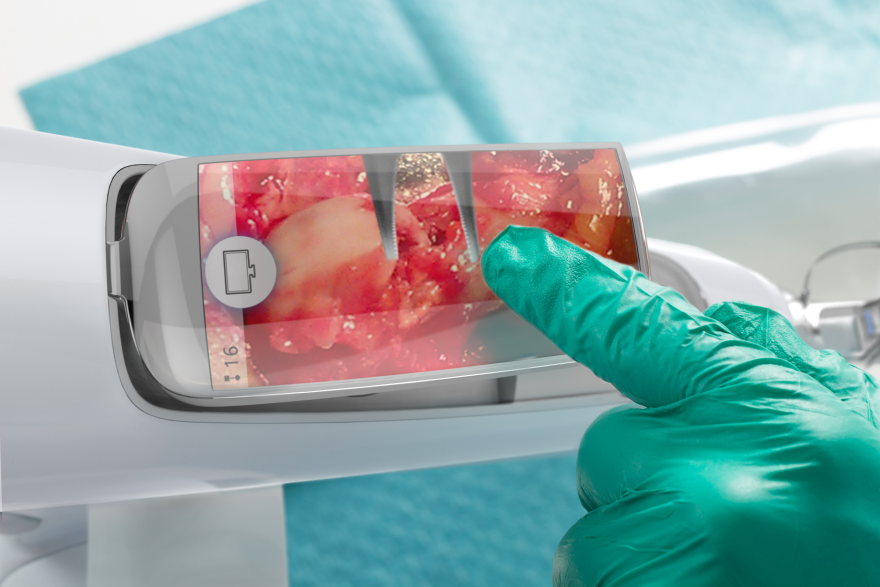Student Notable
Commercial Equipment Award
Core77 Design Awards 2015
Livia – Surgeon’s steady hand
The biggest technical development within the field of surgery is today focused on minimal invasive procedures. With new robot assisted solutions, the surgeons can work more precise and with a great level of flexibility. The work is nevertheless connected to long set-up times, big investments and a tremendous amount of practicing hours.
This project, based on pure user studies and in-depth surgery observations, discovers a possibility to, in a cost efficient way by using off-the-shelf industrial technology, offer robot benefits to open surgery scenarios.
A seamless fusion between handheld surgical instruments, advanced robotics and intuitive self-explanatory interaction gives a versatile, easy-to-use and compact product that enables modern and safe surgery to everyone.
With a minimal effort can the surgeon merge Livia into their regular workflow and enhance the stability in their movements, get improved vision and aid in holding tissue in static positions.




This project is based on design opportunities and insights discovered when following surgeons in their daily work, observing different kinds of operations and interviewing experts. Big technical leap has been taken in the world of minimal invasive procedures and robot assisted surgery where the surgeon gain from drastically improved vision inside the body and extreme control over the instruments’ movements. All new products in this field focus on what is called “elective surgery”, meaning the procedure is well planned ahead with plenty of time and recourses for preparations. This results in a health care where only certain surgical procedures in certain hospitals can offer modern and safe procedures.
Observing open surgery procedures shows that the surgeon would benefit from being able to use robotic aid here as well. Open surgery will always be a big field within surgery, and in emergency situation is it a necessity. Quick set-up times and flexible solutions are the key elements to be able to merge a product into the operation room workflow. By adapting the product to existing roles and rules instead of introducing new ways to work can the product be seamlessly adopted by the surgeons.
It is obvious, during the observations, that being able to switch over to extreme precision in the instruments when working close to sensitive areas, is as big as in minimal invasive operations. In some procedures is the precision needed all the time and in some is it needed to be able to jump from rough hand work to fine-tuned movements seamlessly during the process.
It is tight and dark inside our bodies and magnifying glasses, loupes and head lamps are used all the time. Nevertheless is that not enough – when working inside the body, behind or underneath tissues or organs would the surgeon need an extra eye placed on the fingertip or the instrument. They need to, literally, dive into the body.
During operations can up to six or eight hands be working in the wound at the same time. Some of them are actively working but most of them are holding instruments and tissue in static positions for hours. To be able to leave an instrument in a position and trust it stays there would make it possible for the surrounding staff to take a more active role with quicker and safer procedures as a result.
A big amount of mock-ups, test scenarios and concepts were evaluated and developed together with surgeons to attack the problems at the same time as technical solutions were discussed together with the industry to make sure a cost-effective product could be made.
The result, Livia, is a seamless fusion between handheld surgical instruments, advanced robotics and intuitive self-explanatory interaction which gives a versatile, easy-to-use and compact product that enables modern and safe surgery to everyone.
The instrument can be left in any possible position - a static, secure grip is secured by your extra hand the same second you let your hand off the instrument. Livia remembers the route in and can automatically take the same safe way out. Using cameras and LED light, a clear view of the operation field is transported from the tip of your instrument to a high resolution screen in your field of vision. By adding smooth friction to your movements can extra high precision be achieved in sensitive areas. It connects quick and seamlessly to the hand held instrument on your given command.
Livia is used as an extra hand – empowering the surgeon when needed. It allows modern and safe health care to be used everywhere without excluding institutions without financial muscles.
an exciting union of human- and robotics-based advantages in surgery